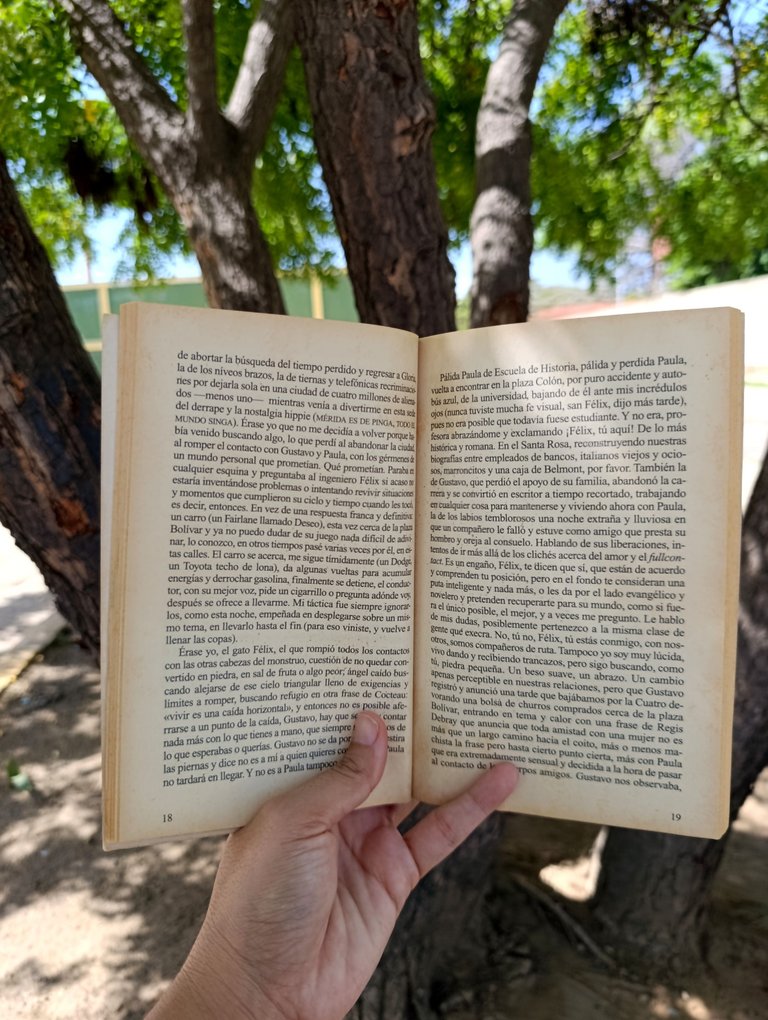I return with another recommendation from my husband, the reading of She is close and comes with a quiet foot by the Venezuelan narrator Ricardo Azuaje, here the stories are developed from a recognizable everyday life and are presented with tints of humor and irony, showing the fears, worries, hardships and decadence of a society.
The stories involve us with relative ease since some characters use informal language, bordering on many Venezuelan colloquialisms, which allows the closeness of the readers of this nationality. Political, economic, cultural and social references are inserted in a well-intentioned way to create the sensation that the narrator projects himself from a pleasant complicity.

The cover was in charge of Mariela Pinto, from the first moment it transmitted me a mysterious air, perhaps those feet are not the most graceful, but the choice of colors gives it a sober tone, a combination that is achieved very well, through the colors black and vinotinto. This is not the first time I have read Azuaje's narrative, so I approached his stories with high expectations.
In my opinion, the most representative stories in this anthology are She is close and comes with a quiet foot and Puertorrico, both narrated with special mastery. Each one has a different theme and an interesting approach, offering elements to reflect on the human condition, identity and migration.
I will begin with She is close and comes with a quiet foot, a story from which the title of the book is taken and whose reference is the anticipation of death, which is not exposed from a tragic point of view. Azuaje builds a disturbing atmosphere, the protagonist, a renowned journalist, is in search of the news that will lead him to fame. The story shows how the perception of time and space is distorted, there is an introspective reflection based on the decisions made in the most transcendental moments of life.

In Puertorrico, on the other hand, I observed two fundamental themes: migration and the search for identity. As she wanders through a country in ruins, despair takes hold of the protagonist. The narrator deftly manages the melancholy between past and present, here emotional memory and rootedness play a vital role. The name of the story may automatically lead to the Caribbean island paradise, and the reference is correct, however, such allusion appears to expose emotional links that are there to show that as human beings we must face crossroads that determine our destiny.
Throughout his narrative, Azuaje invites us to become part of his referents, to immerse ourselves in his works in order to identify with his proposal. I like his style because he tends to leave room for interpretation and participation. It is also evident that he is a master at creating tension and keeping the reader on constant alert.
Versión en EspañolVuelvo con otra recomendación de mi esposo, la lectura de Ella está próxima y viene con pie callado del narrador venezolano Ricardo Azuaje, acá las historias se desarrollan a partir de una cotidianidad reconocible y se presentan con tintes de humor e ironía, mostrando los miedos, las preocupaciones, las penurias y la decadencia de una sociedad.
Los relatos nos envuelven con relativa facilidad puesto que algunos personajes emplean lenguaje informal, rayando en muchos coloquialismos venezolanos, lo cual permite la cercanía de los lectores de esta nacionalidad. Las referencias políticas, económicas, culturales y sociales se insertan de forma bien intencionada para crear la sensación de que el narrador se proyecta desde una agradable complicidad.

La portada estuvo a cargo de Mariela Pinto, desde el primer instante me transmitió un aire misterioso, quizás esos pies no sean los más agraciados, pero la elección de los colores le conceden un tono sobrio, combinación que se logra muy bien, a través de los colores negro y vinotinto. No es la primera ocasión que leo la narrativa de Azuaje, por tal razón abordé sus cuentos con altas expectativas.
Desde mi juicio, los relatos más representativos de esta antología son Ella está próxima y viene con pie callado y Puertorrico, ambos narrados con especial maestría. Cada uno posee una temática distinta y un enfoque interesante, donde se ofrecen elementos para reflexionar sobre la condición humana, la identidad y la migración.
Empezaré con Ella está próxima y viene con pie callado, relato del cual se extrae el título del libro y que cuya referencia es el anticipo de la muerte, misma que no se expone desde un punto de vista trágico. Azuaje construye una atmósfera inquietante, el protagonista, un reconocido periodista, está en busca de la noticia que lo llevará a la fama. En el cuento se puede apreciar cómo se distorsionan la percepción del tiempo y del espacio, hay reflexión introspectiva basada en las decisiones que se toman en los momentos más trascendentales de la vida.

En cambio, en Puertorrico observé dos temas fundamentales: la migración y la búsqueda de identidad. Mientras se pasea por un país en ruinas, la desesperanza se apodera de la protagonista. El narrador maneja con destreza la melancolía entre el pasado y el presente, acá la memoria emocional y el arraigo juegan un papel vital. El nombre del cuento quizás lleve, de forma automática, a la paradisíaca isla del Caribe, y la referencia está en lo cierto, sin embargo, tal alusión aparece para exponer nexos emocionales que están allí para demostrar que como seres humanos debemos enfrentarnos a encrucijadas que determinan el destino.
A lo largo de su narrativa, Azuaje nos invita a formar parte de sus referentes, a sumergirnos dentro de sus obras para identificarnos con su propuesta. Me agrada su estilo porque suele dejar espacios a las interpretaciones y a la participación. También se advierte que es un maestro en crear tensión y mantener en constante alerta al lector.
✓Photos from my personal gallery, edited with Fotocollage.
✓Text translated with DeepL.
📖📚📖📚📖📚📖📚📖
✓Fotos de mi galería personal, editadas con Fotocollage.
✓Texto traducido con DeepL.
Posted Using INLEO